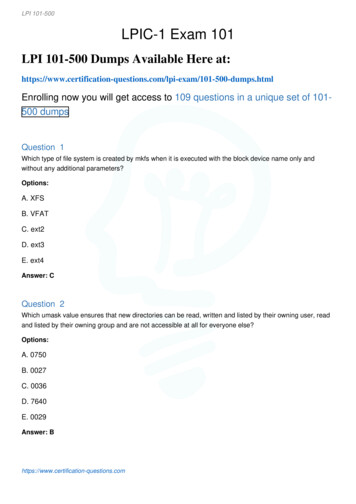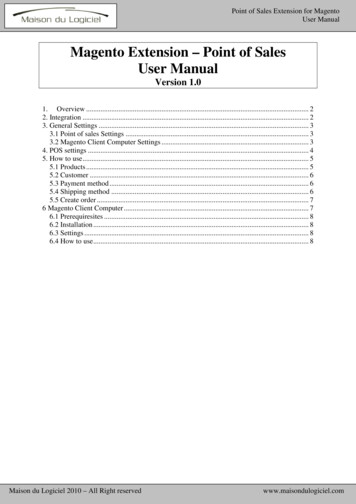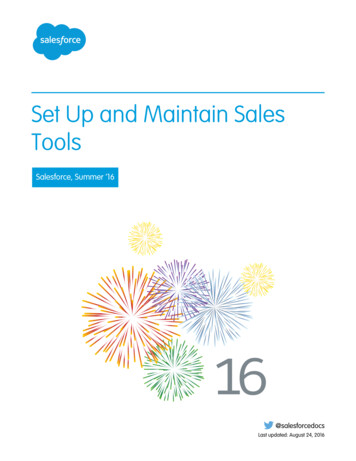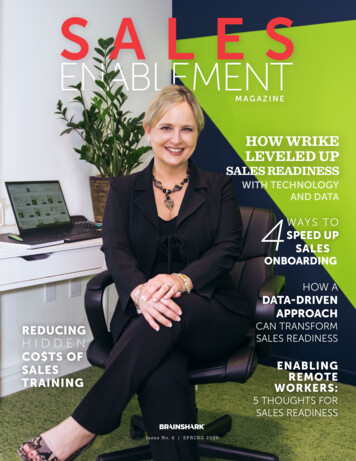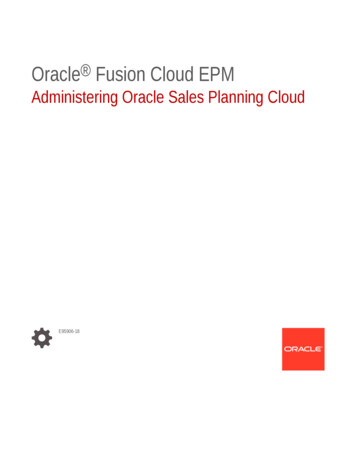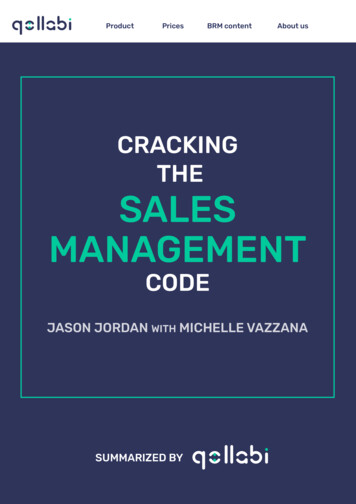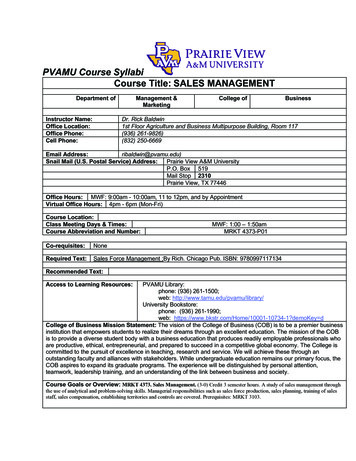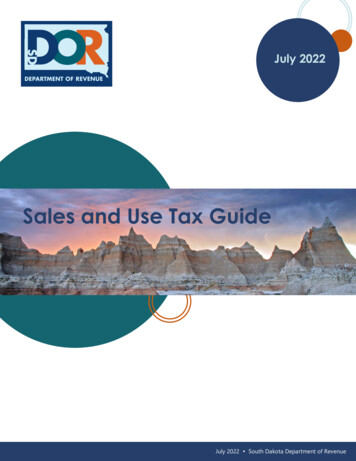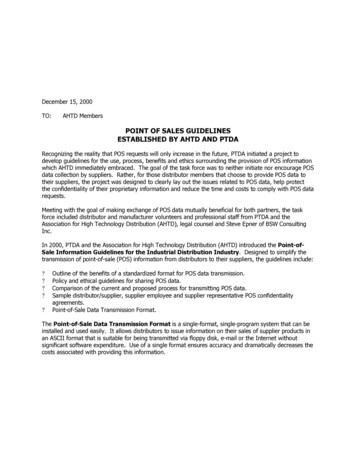
Transcription
December 15, 2000TO:AHTD MembersPOINT OF SALES GUIDELINESESTABLISHED BY AHTD AND PTDARecognizing the reality that POS requests will only increase in the future, PTDA initiated a project todevelop guidelines for the use, process, benefits and ethics surrounding the provision of POS informationwhich AHTD immediately embraced. The goal of the task force was to neither initiate nor encourage POSdata collection by suppliers. Rather, for those distributor members that choose to provide POS data totheir suppliers, the project was designed to clearly lay out the issues related to POS data, help protectthe confidentiality of their proprietary information and reduce the time and costs to comply with POS datarequests.Meeting with the goal of making exchange of POS data mutually beneficial for both partners, the taskforce included distributor and manufacturer volunteers and professional staff from PTDA and theAssociation for High Technology Distribution (AHTD), legal counsel and Steve Epner of BSW ConsultingInc.In 2000, PTDA and the Association for High Technology Distribution (AHTD) introduced the Point-ofSale Information Guidelines for the Industrial Distribution Industry. Designed to simplify thetransmission of point-of-sale (POS) information from distributors to their suppliers, the guidelines include:?Outline of the benefits of a standardized format for POS data transmission.Policy and ethical guidelines for sharing POS data.Comparison of the current and proposed process for transmitting POS data.Sample distributor/supplier, supplier employee and supplier representative POS confidentialityagreements.Point-of-Sale Data Transmission Format.The Point-of-Sale Data Transmission Format is a single-format, single-program system that can beinstalled and used easily. It allows distributors to issue information on their sales of supplier products inan ASCII format that is suitable for being transmitted via floppy disk, e-mail or the Internet withoutsignificant software expenditure. Use of a single format ensures accuracy and dramatically decreases thecosts associated with providing this information.
Point-of-Sales Information GuidelinesFor theIndustrial Distribution IndustryPublished byAssociation for High Technology DistributionAndPower Transmission Distributors AssociationTABLE OF CONTENTS1Preface2Benefits of a Standardized Format3Policy and Ethical Guidelines4Chart of POS Data Processes5Matrix of Point-of-Sale Data6POS Confidentiality Agreements7POS Transmission Format v.1.0
PrefaceIncreasingly, industrial distributors are being asked to share Point-of-Sale (POS) information withtheir manufacturer suppliers. The type of information requested varies widely, based on eachsupplier’s planned purpose for the information. Common requests include total sales of their productfor a specific category, such as by county, state, zip code, Standard Industrial Classification (SIC)code or North American Industrial Classification System (NAICS) code. More detailed POS requestsmay include customer name and address, item sold, selling price and invoice date.Once collected, POS data may be used by suppliers to calculate sales force compensation, toanalyze sales trends by region or SIC/NAICS code, to plan production and inventory levels or forother purposes. Some suppliers share summary POS data with their distributors for their ownplanning purposes, but others do not.From a distributor perspective, the requested POS information is often considered proprietary. Inorder to establish some minimum comfort level with this information exchange, there should besome parameters established to protect the confidentiality of both parties’information.In 1999, in response to distributor member concerns that they were receiving an increased numberof requests for Point-of-Sale (POS) data from their suppliers, the Power Transmission DistributorsAssociation initiated a project to develop guidelines for transmission of POS data. In an attempt tomake the project as broad-based as possible, input and participation was solicited from otherindustrial distributor associations. The final task force included distributor and manufacturervolunteers, as well as professional staff, from the Association for High Technology Distribution andthe Power Transmission Distributors Association.The goal of the task force was to neither initiate nor encourage POS data collection by suppliers.Rather, reflecting a reality where distributors are increasingly required to provide such data, theproject was designed to clearly lay out the issues related to POS data, help protect distributorproprietary information and minimize costs for those distributors required to submit reports tomultiple suppliers.The enclosed documents were developed by the task force with the goal of making exchange ofPOS data mutually beneficial for distributor and supplier partners. The documents outline policy andethical guidelines for sharing POS data, benefits of a standardized format for exchange of POS data,differences in the current and proposed systems, sample confidentiality agreements, a matrix ofPOS data and a standardized format for transmission of this data.The enclosed Distributor/Supplier POS Confidentiality Agreement could serve as a stand-alonedocument or could be incorporated into the distribution agreement between the parties. TheSupplier Employee POS Confidentiality Agreement and Supplier Representative POS ConfidentialityAgreement are samples for those suppliers who do not already have confidentiality agreements withemployees or representatives and who choose to use such a document as a means of reinforcingthe supplier's obligation to maintain the confidentiality of the distributor's proprietary information.
Benefits of a Standardized Format forExchange of Point-of-Sale DataAdoption of a standardized reporting format for transmission of Point-of-Sale (POS) data fromdistributors to their supplier partners will significantly streamline this process, leading to cost savingsfor all channel partners. Adoption of a single format would allow distributors to prepare reports formultiple vendors in a unified format; suppliers would be able to input, sort and analyze this datausing an automated process.Specifically, the following benefits are expected from use of a standardized format for POS dataexchange:?Industry-supported standard with cross-product line application.Reduced time to negotiate distributor-supplier agreements regarding transmission of POS data.Increased likelihood of suppliers receiving desired data due to ease of reporting.Reduced time for distributors’administrative personnel to prepare reports.Reduced distributor error in preparing reports, improving data quality.Reduced time for distributor and supplier information systems personnel to develop programs toexchange POS data.Eliminate rekeying of data by supplier personnel.
Policy and Ethical Guidelines for Sharing Point-of-Sale DataWith the intent of insuring that the exchange of Point-of-Sale (POS) data between distributionchannel partners is mutually beneficial, the Association for High Technology Distribution and thePower Transmission Distributors Association endorse the following policy concerning guidelines forthe ownership and ethical use of the proprietary information:1. Proprietary information furnished in a POS Report constitutes trade secrets that are and shallremain the property of the reporting distributor.2. Proprietary POS data is furnished to suppliers for their internal use only (including suppliers’agents) and for the limited purposes of paying commissions to their sales representatives andstudying their markets.3. In exchange for providing POS data to their supplier partners, it is expected that distributors willreceive summary data from their suppliers for studying their markets and developing marketingplans.4. The categories of data that will be provided by distributors to suppliers and by suppliers todistributors are subject to negotiation between individual distributors and their supplier partners.5. Suppliers and their representatives are expected to keep and maintain proprietary distributorinformation in a manner that will prevent disclosure to any outside party. This obligation toprevent disclosure remains in effect after the termination of the distributorship arrangement bythe distributor, supplier or independent sales representative, for any reason whatsoever.Information that is publicly available, available to the supplier through another source, alreadyknown by the supplier or independently developed by the supplier will not be consideredproprietary.6. POS data or analysis derived from this data shall not be used by any supplier personnel, agentor other authorized distributors to the detriment of or to damage the distributor or thatdistributor’s sales of any products to any of its customers.7. Distributors and their representatives are expected to keep and maintain proprietary supplierdata in a manner that will prevent disclosure to any outside party. POS and other marketanalysis provided by the supplier to the distributor shall not be used by any distributor personnelto the detriment of or to damage the supplier or that supplier’s sales of any products to any of itscustomers.8. This policy regarding the ownership and ethical use of proprietary Point-of-Sale informationshould be incorporated into a Distributor/Supplier POS Confidentiality Agreement that specificallyaddresses:a.b.c.d.e.Information to be provided;Information considered proprietary;Use and purpose of proprietary information;Disposition of the information in the event of termination;Steps to protect confidentiality.
Chart of Existing and Proposed Point-of-Sale Data ProcessesStandardization of the reporting format for transmission of Point-of-Sale (POS) data will streamlinethis process, leading to savings in costs and personnel time by all channel partners. Adoption of asingle format will allow distributors to prepare reports for multiple suppliers in a unified format;suppliers will be able to input, sort and analyze this data using an automated process. Reportsanalyzing this data can be created easily, providing valuable business data to both channel partners.The proposed process can also replace existing sales force compensation reports.The following flowchart outlines the existing process for sharing POS data and the streamlinedprocess that will result from adoption of the POS guidelines.Current ProcessProposed ProcessEnd of eachmonth:Distributor collects and collatesPOS data from all sources.End of eachmonth:Distributor collects and collatesPOS data from all sources into asingle format.Within 1030 daysafter monthend:Distributor prepares POSreports (using format defined byeach supplier) and sends to allrequesting suppliers (via disk,tape, modem, Internet or paper).Within 5-10days aftermonth end:Distributor prepares and issuessingle-format POS reports to allrequesting suppliers (via disk,tape, modem, Internet or paper).Within 3060 daysafter monthend:Supplier receives POS datafrom all distributors, sorts andanalyzes data to create customreports.Within 1015 daysafter monthend:Supplier receives uniformlyformatted POS data from alldistributors; supplier’s computersystem automatically sorts andanalyzes data to createstandardized or custom reports.Within 3090 daysafter monthend:Supplier issues POS reports inchosen format to reps anddistributors, who rekey and sortdata for their own use.Within 30days aftermonth end:Supplier issues uniformlyformatted POS reports (via disk,tape, modem, Internet or, ifnecessary, paper) to reps anddistributors for their own use.
Matrix of Point-of-Sale DataThe following types of data have been identified as candidates for inclusion in Point-of-Sale (POS)data transmission. For each category of desired data, a supplier is expected to identify why thisinformation is desired as a starting point for negotiation.Based on input from task force of distributor and manufacturer volunteers, the following data fieldsare considered likely to be available upon manufacturer request.Branch CodePart NumberUPCQuantityUnit of MeasureUnit CostShip To State/ProvinceShip To ZIP/PostalShip To CountryBill To State/ProvinceBill To ZIP/PostalBill To CountryCustomer Standard Industrial Classification (SIC) CodeCustomer North American Industrial Classification (NAICS) CodeProduct DescriptionThe following data fields may be desired by suppliers, but provision of this information will morelikely be dependent upon negotiation with each distributor partner on a “need to know”basis.Customer Identification NumberShip To CityShip To CountyBill To CityBill To CountyCustomer NameProduct Category/FamilyProduct Category/Family Definition CodeUnit PriceAssemblyBased on negotiation with each distributor partner, additional fields may be defined by the user.
Distributor/SupplierPOS Confidentiality AgreementAgreement dated this day of , , between(“Distributor”) and (“Supplier”).RECITALSA.In connection with the distributorship arrangement between Supplier and Distributor,Distributor may from time to time furnish Supplier certain otherwise confidential informationconcerning Distributor’s business and customers, including, by way of example, sales informationsuch as customer lists, point-of-sale reports, sales volume data, pricing data, and other informationrelating to customer methods, operations, financing and services of Distributor (“ProprietaryInformation”).B.The Proprietary Information is furnished to Supplier for Supplier’s internal use only and forthe limited purposes of allocating sales commissions to Supplier’s sales representatives andperforming market research and analysis.C. Supplier recognizes and respects Distributor’s proprietary rights and interest in the ProprietaryInformation.D. The Supplier may prepare summary reports for Distributor based upon Distributor’s and otherdistributors’aggregated Proprietary Information.E. Distributor recognizes and respects Supplier’s proprietary rights and interest in such summaryreports.In consideration of the above recitals, which are hereby made a part of the terms of thisAgreement, and the promises set forth below, the parties hereby agree as follows:1.Proprietary Information furnished by Distributor to Supplier shall be expressly designated andconspicuously marked by Distributor as “CONFIDENTIAL,”either via a stamped hard copy or via adesignation in an electronic communication. Proprietary Information shall not include informationwhich (a) is or becomes generally available to the public through no fault of Supplier, or (b) becomesavailable to Supplier on a nonconfidential basis from a source which is not prohibited from disclosingsuch information to Supplier by a contractual, legal or fiduciary obligation, or (c) was already knownto Supplier at the time of disclosure, or (d) was independently developed by Supplier by personswithout access to the Proprietary Information.2.Proprietary Information, so marked, shall be and remain the property of Distributor, andSupplier acknowledges that the Proprietary Information constitutes confidential trade secrets ofDistributor. Supplier shall not, during the continuance of the distributorship arrangement with theDistributor or at any time thereafter, directly or indirectly, disclose to others or use any of theProprietary Information for the benefit of any person, corporation, or other entity, or itself, or to thedetriment or damage of Distributor or Distributor’s sales of any products to any of its customers.3.Supplier agrees that it shall keep and maintain the Proprietary Information in a manner so asto prevent disclosure to any third party and to limit access to the Proprietary Information to such ofits employees or agents, such as manufacturer representatives, as are required to have such accessfor the purposes described in Section B above. Supplier agrees to protect the confidentiality of the
Proprietary Information and agrees to assume responsibility for insuring that none of Supplier’semployees or agents shall disclose any of the Proprietary Information other than as authorized bythis Agreement.4.Supplier may provide aggregated, summary information, which includes ProprietaryInformation, to Distributor and other distributors, provided that data from at least three distributors isincluded in each category such that Distributor’s Proprietary Information is not revealed to thirdparties.5.Distributor agrees that it shall keep and maintain such aggregated, summary data receivedfrom Supplier in a manner so as to prevent disclosure to any third party and to limit access to suchdata to such of its employees or agents as are required to have such access for the purposes ofselling Supplier’s products. Distributor agrees to protect the confidentiality of such data and agreesto assume responsibility for insuring that none of Distributor’s employees or agents shall disclosesuch data other than as authorized by this Agreement.6.Upon the termination of the distributorship arrangement by either party for any reasonwhatsoever, all point-of-sale reports and other tangible embodiments of Proprietary Information(whether preserved in hard copy, magnetic or electronic media or otherwise) and each and everycopy, abstract, or reproduction of such Proprietary Information made by or for Supplier or receivedby Supplier and still in existence shall be destroyed by Supplier and within thirty (30) days of thetermination of distributorship arrangement Supplier shall provide Distributor with written certificationthat said Proprietary Information has been destroyed and will not be used by any of Supplier’spersonnel or other authorized distributors or by any other person or entity to the detriment ordamage of Distributor.IN WITNESS WHEREOF, the parties have signed this Agreement on the date set forth above.DistributorSupplierBy:By:Its:Its:
Supplier Employee POSConfidentiality AgreementIn connection with the distributorship arrangement between Supplier and Distributor, the partieshave entered into a Distributor/Supplier POS Confidentiality Agreement, pursuant to whichDistributor has designated certain Proprietary Information provided to Supplier as “CONFIDENTIAL.”Upon being provided with any such Proprietary Information, Employee hereby agrees to utilize suchDistributor Proprietary Information only for the limited purposes of allocating sales commissions toSupplier’s sales representatives and/or performing market research and analysis. During andfollowing his/her employment with Supplier, Employee agrees he/she will not, directly or indirectly,disclose to others or use any such Proprietary Information for the benefit of any person, corporation,or other entity, or himself/herself, or to the detriment or damage of Distributor or Distributor’s sales ofany products to any of its customers.IN WITNESS WHEREOF, Employee has signed this Agreement on the date set forth below.EMPLOYEEDate:
Supplier Representative POSConfidentiality AgreementIn connection with the distributorship arrangement between Supplier and Distributor, the partieshave entered into a Distributor/Supplier POS Confidentiality Agreement, pursuant to whichDistributor has designated certain Proprietary Information provided to Supplier as “CONFIDENTIAL.”Upon being provided with any such Proprietary Information, Representative hereby agrees to utilizesuch Distributor Proprietary Information only for the limited purposes of allocating sales commissionsto Supplier’s sales representatives and/or performing market research and analysis. During andfollowing its representation of Supplier, Representative agrees it will not, directly or indirectly,disclose to others or use any such Proprietary Information for the benefit of any person, corporation,or other entity, or itself, or to the detriment or damage of Distributor or Distributor’s sales of anyproducts to any of its customers.IN WITNESS WHEREOF, Representative has signed this Agreement on the date set forth below.REPRESENTATIVEBy:Its:Date:
AHTD/PTDA Point-of-Sale Data Transmission FormatVersion 1.0The following format was developed by a joint task force of volunteers from the Association for HighTechnology Distribution (AHTD) and the Power Transmission Distributors Association (PTDA). Thisformat is recommended for the electronic transmission of point-of-sale (POS) data betweendistributor and supplier and is designed for use by any firm in the industrial distribution industry.Endorsement of the format as written by other trade associations is welcome.This format is designed to increase the efficiency of POS data transmission by providing a singleformat and providing common categorization of data. Decisions as to what information will beprovided and appropriate uses of this data are open to negotiation between distributor and supplier.Questions or suggested improvements may be directed to Patricia Lilly, AHTD ( 1.215.564.3484;plilly@fernley.com) or Stephanie Kaplan, PTDA ( 1.312.876.9461; sakaplan@ptda.org). The mostrecent version of the format is available on request from any of the sponsoring associations.This format includes three files:?The header file identifies the distributor that is transmitting the data and defines the generalparameters of the database file.The data file contains information about distributor sales to customers and is submitted on aschedule negotiated between the distributor and supplier.The trailer file contains unique identification information referenced in the header record andindicates the total number of records transmitted as part of a single transmission.To ensure the confidentiality of your POS data, 128-byte encryption or better is recommended. Ifyou are sharing data with international trading partners, please verify that the encryption routine youhave selected is approved for export under the national security regulations of your country.Format RulesAll fields are ASCII format, variable length, and “tab”delimited. Each record ends with a CR/LF(carriage return/line feed).Physical decimal points must be used in all numeric fields that require them; a numeric field withouta decimal will be considered an integer.Distributors have discretion to provide or not provide any of the data fields except the ones markedas “M”(Mandatory). Consecutive fields marked “E”(Either) indicate that one of these fields must besupplied; both may be supplied if information is available. Distributors may ignore data fields thatare not required for their application. If a field is not supplied, the position is filled with a “null”character; two delimiters in a row (tab tab) represent a null character.All codes will use ASC X12 EDI standards where they are defined. Where relevant, the Definitionand Comment line for each field refers to the ASC X12 table where field values can be found.
The date of this release is May 31, 2000, Version 1.0.Header RecordN1MMField NameData Type2MTransmissionControl Number34M5EDistributor NameDistributorAddressDistributorContact PhoneNumber6EDistributor E-mailAddressDefinition and CommentsIdentification field categorizing data; in most cases, this will read“Distributor Point-of-Sale Data.”Numeric. This series is automatically assigned for each transmissionfrom the distributor to a particular supplier, beginning withtransmission zero. The numbering system rolls over with the firsttransmission sent in a new calendar year.Free format field with the distributor name.Free format field with the street address or P.O. Box where thedistributor can be contacted.Numeric; formatted AAAEEENNNNXXXX, where AAA indicates thearea code, EEE indicates the exchange, NNNN indicates the number,and XXXX indicates the extension and no dashes are included. Thisis a phone number where a technical contact or person responsiblefor e-mailing this transmission may be reached.E-mail address where a technical contact or person responsible for emailing this transmission may be reached.Data RecordsN1MMField NameTransaction Date2M3MTransmissionRecord NumberDistributor IDDuns 4 Number4567Branch CodeEE8Unit of Measure910MM11M12Part NumberUPCQuantityUnit CostUnit CostIdentifierUnit CostCurrency CodeCustomerIdentificationNumberDefinition and CommentsNumeric; formatted YYYYMMDD. For sales (field 7 is positive), thisfield indicated the date the invoice was generated for this line item; ifsummary billing is used, this is the date the invoice would normallyhave been generated. For returns (field 7 is negative), this fieldindicates the date credit was issued to the customer.Numeric; a sequential number representing this unique data record forthis transaction date.Duns 4 number for this distributor. Where multiple Duns 4 numbersare available, use the selling facility, not the number of aconglomerate or holding company.Alphanumeric. For use in designating for which branch data issubmitted where the distributor uses a single Duns number for alllocations.Alphanumeric. Supplier part number.Numeric. Supplier UPC product number (13 digits).Numeric. Quantity of product sold (positive) or returned (negative). Ifnot null, must be accompanied by a unit of measure.Alphanumeric. The unit of measure sold or credited for this record.Use the attached list of ASC X12 standard codes (Table 355— Unit ofMeasurement Code). Use of a nonstandard code is not allowed.Numeric.Use the attached list of ASC X12 standard codes (Table 639— UnitCost Identifier Codes). Use of a nonstandard code is not allowed.Use the attached list of ISO standard codes (Table 4217— ISO 3Letter Alphabetic Currency Codes). Use of a nonstandard code is notallowed.Alphanumeric. Internal “Ship To”identification.
131415Ship To CityShip To CountyShip ToState/Province16Ship ToZIP/PostalShip To Country17181920Bill To CityBill To CountyBill ToState/Province21Bill To ZIP/Postal22Bill To Country2324SICNAICS2526Customer Definition CodeUnit Price2829Unit PriceIdentifierUnit PriceCurrency Code3031ProductDescriptionAssembly32Alphabetical. Customer city.Alphabetical. Customer county.Customer state or province. Use the attached list of standard U.S.and Canadian postal abbreviation codes. Use of a nonstandard codeis not allowed.Alphanumeric. Customer ZIP or Postal Code without punctuationmarks.Customer country. Use the attached list of ISO standard codes(Table 3166-1— ISO 2-Letter Alphabetic Country Codes). Use of anonstandard code is not allowed.Alphabetical. Customer city.Alphabetical. Customer county.Customer state or province. Use the attached list of standard U.S. andCanadian postal abbreviation codes. Use of a nonstandard code isnot allowed.Alphanumeric. Customer ZIP or Postal Code without punctuationmarks.Customer country. Use the attached list of ISO standard codes(Table 3166-1— ISO 2-Letter Alphabetic Country Codes). Use of anonstandard code is not allowed.Numeric. Customer Standard Industrial Classification code.Numeric. Customer North American Industrial Classification Systemcode.Alphanumeric.Alphanumeric. Schema relating part number or UPC to a largercategory that has been agreed to by distributor and supplier partner.Must be consistent over the reporting period.Alphanumeric. Use the list of codes developed by distributor andsupplier.Pretax unit price excluding freight, any charges for engineeringsupport and total order discounts.Use the attached list of ASC X12 standard codes (Table 639— UnitCost Identifier Codes). Use of a nonstandard code is not allowed.Use the attached list of ISO standard codes (Table 4217— ISO 3Letter Alphabetic Currency Codes). Use of a nonstandard code is notallowed.Free format field. Use if there is no part number or UPC code.Free format field. Use to indicate if referenced product is anassembly.Trailer RecordN1MMField NameTransmissionControl Number2MRecord CountDefinition and CommentsNumeric. This series is automatically assigned for each transmissionfrom the distributor to a particular supplier, beginning withtransmission zero. The numbering system rolls over with the firsttransmission sent in a new calendar year. This number must be thesame as Field 2 in the Header RecordNumeric. Number of Data Records in this transmission.
Suggested Unit Cost Identifier CodesData Element Dictionary Table 639ASC X12The following table reproduces ASC 12 – 639. Please use only codes that have been accepted intothis vise PriceAverage Wholesale PriceBefore DiscountBrokerBiweekly Price per UnitCatalogCurrent Price (Subject to Change)ContractDistributorDealerDiscountEstimated CreditEstimatedFixed PricePer 100 FeetPrice per HundredCatalog Price per HundredCatalog Price per DozenCatalog Price per EachCatalog Price per ThousandPrevious Catalog PriceMidterm Endorsement Price per UnitNo ChargeNot to ExceedNo QuoteNetPrice per Troy OunceAnnual Price per UnitPrice per DozenPrice per EachPrice per FootMonthly Price per UnitPrice per TenPrice per OuncePrice per PoundPromotionPrice per Thousand Square TBTCTDTETFTMTPUMVQWCWDWEWHWIWMExplanationPrice per TonQuarterly Price per UnitProvisional PricePrice per YardQuoted Price per EachQuoted Price per HundredPrevious Quoted PriceQuoted Price per ThousandQuotedRetail Price per HundredRetail Price per DozenRetail Price per EachRetail Price per ThousandResale PriceRetailSemiannual Price per UnitSubmitted ContractSemi Monthly Price per UnitSuggested RetailStandardSubmitted WholesaleTo be negotiatedContract Price per HundredContract Price per DozenContract Price per EachPer 1000 FeetContract Price per ThousandPrice per ThousandPrice per Unit of MeasureVerbal QuoteWholesale Price per HundredWholesale Price per DozenWholesale Price per EachWholesaleWeekly Price per UnitWholesale Price per Thousand
Suggested
Point -of Sale Data Transmission Format. The Point-of-Sale Data Transmission Format is a single-format, single-program system that can be installed and used easily. It allows distributors to issue information on their sales of supplier products in an ASCII format that is suitable for being transmitted via floppy disk, e-mail or the Internet without
